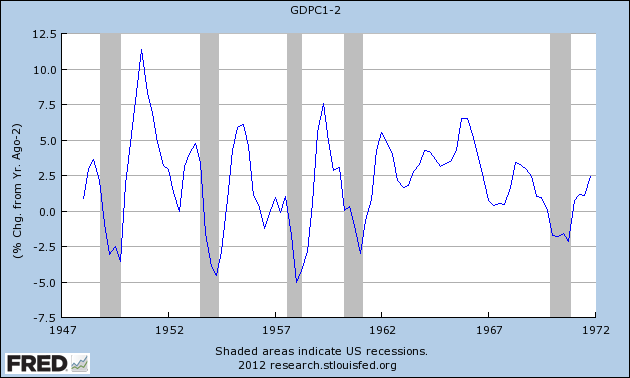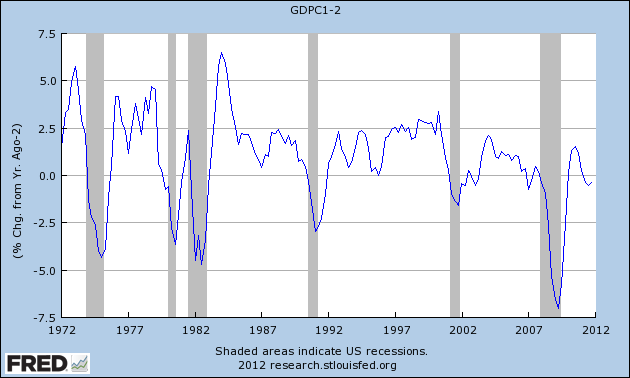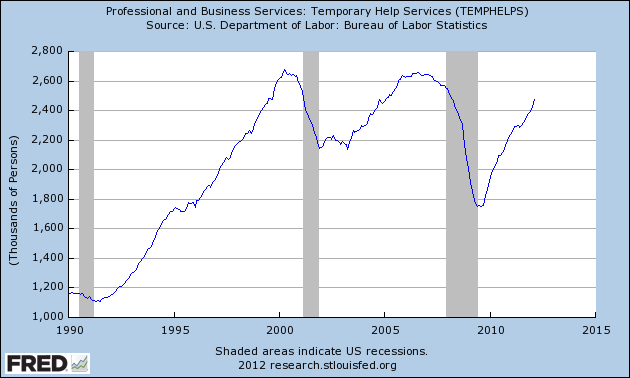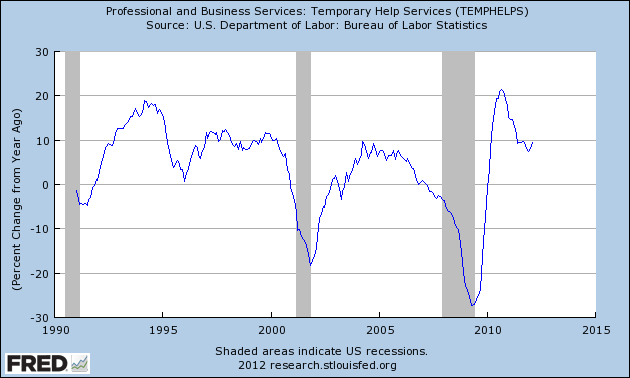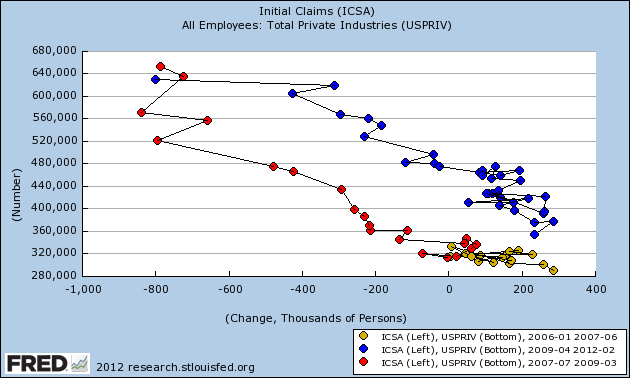The monthly data releases this week were mainly about housing. Permits, an important long leading indicator, rose to a 3 year high. Starts were flat, as were existing home sales. New single family home sales also rose slightly. February leading indicators rose .7, although January was revised down from .4 to .2. The Conference Board's official measure indicates we should be going through a rough patch right now, but growth should reassert itself going into late spring and summer.
Turning to the high frequency weekly indicators , let's start with housing, in which a number of indicators add to the mounting evidence that we are at a turning point:
The Mortgage Bankers' Association reported that the seasonally adjusted Purchase Index decreased -1.0% from the prior week, and was -1.9% lower YoY. The Refinance Index decreased -4.1% from the previous week, reflecting higher rates. Because the MBA's index was substituted for the Federal Reserve Bank's weekly H8 report of real estate loans in ECRI's WLI, I've begun comparing the two to see if there are some important differences. There are. This week for the first time in nearly three years real estate loans held at commercial banks were flat (technically, -0.02%) rather than negative on a YoY basis. The seasonally adjusted data has turned up sharply since its possible bottom in December 2011.
YoY weekly median asking house prices from 54 metropolitan areas at Housing Tracker were up +3.6% from a year ago. This number peaked at over +4% in February. It remains at odds with the Case-Shiller reports of worsening YoY declines in price for comparable sales. On the other hand, Housing Tracker's reversal of direction was supported this week by the Census Bureau's report on new home sales and by the NAR's report on existing home sales, both of which showed YoY increases in price, and by FHFA's January home sales report, which showed only a -0.8% decline YoY. Typically non-seasonally adjusted home sales prices peak in about June, so we should see in the next 14 weeks which one of the two metrics is going to turn.
Employment related indicators were all positive:
The Department of Labor reported that Initial jobless claims fell 3,000 to 348,000 last week, the lowest initial report in 4 years. The four week average declined by 500 to 355,000.
The Daily Treasury Statement showed that for the first 16 days of March, $131.7 B was collected vs. $128.6 B a year ago. In the last 20 reporting days, $162.2 B was collected vs. $157.9 B for the equivalent 20 day period in 2011, an increase of 2.7%.
The American Staffing Association Index rose by one to 88. It remains midway above its 2011 level and below its 2007 level and has begun to rise seasonally as expected.
Sales turned more strongly positive.
The ICSC reported that same store sales for the week ending March 17 rose +0.9% w/w, and also rose only +3.3% YoY. Johnson Redbook reported a 3.6% YoY gain. This week was the best week in over a month. The 14 day average of Gallup daily consumer spending rose to its highest springtime level in 4 years, after having been briefly negative YoY at the beginning of this month. Shoppertrak's data for the beginning of the month was also belatedly reported as off -3.4% YoY.
Money supply was generally positive:
M1 rose +0.4% last week, but was lower by -0.2% month over month. On a YoY basis it rose to +17.9%, so Real M1 is up 15.1%. YoY. M2 was up +0.1% for the week, and also up +0.2% month over month. Its YoY advance rose slightly to +9.9%, so Real M2 was up 7.1%. Real money supply indicators continue slightly less strongly positive on a YoY basis, although not so much as in previous months, and have generally stalled in the last couple of months.
Bond prices and credit spreads both fell:
Weekly BAA commercial bond rates rose +.17% t0 5.28%. Yields on 10 year treasury bonds rose +.21% to 2.21%. The credit spread between the two, which had a 52 week maximum difference of 3.34% in October, declined another .04 to 3.07%. As I have previously said, narrowing credit spreads are not at all what I would expect to see if we were going into a recession, and are a major reason why ECRI's WLI growth index is on the verge of turning positive.
Rail traffic remained negative but with the same explanation.
Money supply was generally positive:
M1 rose +0.4% last week, but was lower by -0.2% month over month. On a YoY basis it rose to +17.9%, so Real M1 is up 15.1%. YoY. M2 was up +0.1% for the week, and also up +0.2% month over month. Its YoY advance rose slightly to +9.9%, so Real M2 was up 7.1%. Real money supply indicators continue slightly less strongly positive on a YoY basis, although not so much as in previous months, and have generally stalled in the last couple of months.
Bond prices and credit spreads both fell:
Weekly BAA commercial bond rates rose +.17% t0 5.28%. Yields on 10 year treasury bonds rose +.21% to 2.21%. The credit spread between the two, which had a 52 week maximum difference of 3.34% in October, declined another .04 to 3.07%. As I have previously said, narrowing credit spreads are not at all what I would expect to see if we were going into a recession, and are a major reason why ECRI's WLI growth index is on the verge of turning positive.
Rail traffic remained negative but with the same explanation.
The American Association of Railroads reported a -11,100 car decline in weekly rail traffic YoY for the week ending March 17, 2012, for a decline of -2.2% YoY. Intermodal traffic was up 4500 carloads, or +2.0%, but other carloads decreased -15,500, or -5.3% YoY. The entire decline in carloads is still due to coal shipments which were off -19,500 carloads or -14.7%. Railfax's graph of YoY traffic by types remains in a positive trend but deteriorated this week.
The energy choke collar remains engaged:
Gasoline prices are about 8.7% higher than one year ago while usage continues to be much lower: Oil was slightly lower at $106.87. Gas at the pump rose another $.04 to $3.87. Both of these are significantly above the point where they can be expected to exert a constricting influence on the economy. Gasoline usage, at 8379 M gallons vs. 9074 M a year ago, was off -7.7%. The 4 week moving average is off -7.8%. The 4 week average is off sufficiently both from a year ago, and from its YoY readings from the last 6 months, to be a yellow flag warning of further economic weakness.
Turning now to high frequency indicators for the global economy:
The TED spread rose .01 to 0.400. This index remians slightly below its 2010 peak, generally steady for the last 5 weeks, and has declined from its 3 year peak of 3 months ago. The one month LIBOR declined .001 to 0.241. It is well below its 12 month peak set 3 months ago, remains below its 2010 peak, and has returned to its typical background reading of the last 3 years.
The Baltic Dry Index at 908 was up 34 from 874 one week ago, and up 258 from its 52 week low, although still well off its October 52 week high of 2173. The Harpex Shipping Index was up 7 from 386 to 393 in the last week, up 18 from its 52 week low. Please remember that these two indexes are influenced by supply as well as demand, and have generally been in a secular decline due to oversupply of ships for over half a decade. The Harpex index concentrates on container ships, and led at recent tops and lagged at troughs. The BDI concentrates on bulk shipments such as coal and grain, and lagged more at the top but turned up first at the 2009 trough.
Finally, the JoC ECRI industrial commodities index fell from 126.06 to 125.74 I have added this report as an indicator for the global economy, which ought to suggest a severe limitation I helieve it has as a barometer of the US economy alone.
While gasoline prices remain an ongoing concern, and while decreased mining, shipping, and usage of coal (probably due to the non-winter winter) will exert a negative influence on Q1 GDP, the remaining indicators were virtually all positive this week. There is no sign whatsoever of any imminent economic contraction. To the contrary, that almost all housing and real estate data has turned flat or is rising slightly is a very good sign for the economy going forward. We'll see what happens with construction spending and the Case-Shiller indexes this coming week.
Have a good weekend.























